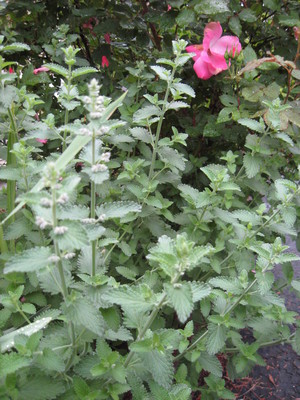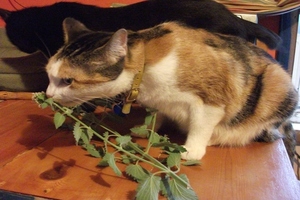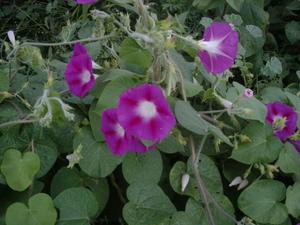I had just taken some cuttings from the catmint growing in my garden, because I wanted to get some new plants started. The next thing I knew, our cat Daphne, who never gets on our kitchen counter, was on the kitchen counter with her nose stuck in the middle of the catmint. You might also find yourself enjoying the scent of this luscious herb as much as cats do.
Do not confuse catmint and catnip; even though, many people use the names interchangeably. The two plants are not the same. Catnip – the plant that cats love and which could easily be nicknamed “kitty-cat marijuana” — is Nepeta cataria. Cats love to east this plant. I actually tried to grow catnip once. We had an outside cat at the time named Willie. Willie would allow about 3-4 leaves to develop on a stem before he would munch on them. As a result, I was left with a bunch of catnip stems. My husband and I contemplated an intervention and kitty-cat rehab; however, I just finally gave up on the whole idea of growing catnip.
Catmint, on the other hand, is Nepeta faassenii. (This is one instance when you really need to know the Latin name in order to get the right plant. There is a N. mussinii, which is not as pretty as N. faasenii nor quite as hardy.) Catmint has fuzzy, grayish-green leaves, which have a wonderful spicy-mint aroma. While cats will not eat catmint, they do seem to be drawn to the scent. If you ever walk out and see a flat depression in the middle of your catmint, you have had a cat laying in your plant. I have not had this problem, however. The cats in my neighborhood just like to smell it. There was one cat that loved to lay under it with her nose stuck up in the middle of the catmint. If you do have trouble, though, with cats laying right on top of your catmint, you can put a light mesh over the plant.
Catmint is a hardy perennial that grows 18 inches to two-feet tall. In my Zone 6 area of East Tennessee, it tends to be one of the first plants to emerge in the early spring and will be in full bloom by the end of April or the first of May. The small lavender-blue blooms are carried on spikes that are about a foot long (or even longer). Shearing them back will encourage re-blooming, which can continue into the early fall. Regular pruning can also keep it more compact and looking tidy. Catmint is not as invasive as other mints. In fact, it has a tendency to grow in relatively well-behaved clumps. It can be divided in the early spring or fall. I have also had a great deal of luck by propagating catmint from stem cuttings. Catmint prefers well-drained soil and does not respond well to conditions that are too moist. It does best in full sun; however, catmint can tolerate some shade.
You will want to plant your catmint at the front of your border where its heavenly scent can be enjoyed. It is also an ideal companion plant for
roses. The gray-green clumps of the catmint hide the not-so-pretty crowns of the roses. In addition, catmint puts nutrients back into the soil that roses need. Another plus to having catmint in your garden is that it repels rodents, such as mice and rats. (I have also noticed that squirrels and chipmunks do not particularly like to be around the catmint either.)
Catmint is one of my favorite plants to grow in the garden. Once you smell the aroma of this lovely plant and realize that each it is much better behaved than other mints, I am certain it will become one of your favorites, too.
For more on catmint versus catnip, see: Is Cat Mint the same as Catnip?
To see more photos of catmint in my garden, visit Dena’s Garden
To learn more about our cat Daphne, read: Life with Cat: Part I: Daphne






